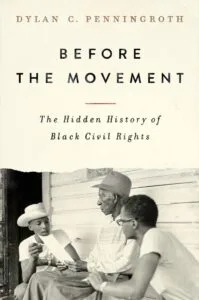In April 1976, my twenty-seven-year-old uncle, Craig Baskerville, made a tape recording of his great-uncle, Thomas Holcomb. The tape is scratchy, and Lady, the family dog, keeps barking in the background. “My father was a runaway man,” my great-great-uncle Tom says. “He was a slave” in Cumberland County, Virginia, near the Appomattox River, and “he had a boat.” Sometime in the spring of 1865, after the Battle of Richmond, when Confederate soldiers were “running all through the woods,” Jackson Holcomb “was down there” ferrying those “Jeff Davis men . . . across.” “And everybody he put em across the river they give him money.” They “paid him.” On the recording, my uncle Craig sounds a little puzzled. Thomas Holcomb seems to be saying that his father had a piece of property, and that he used that property to make deals that sound a lot like contracts: a promise to pay in exchange for a promise to ferry. Why would a band of heavily armed white men, who were risking their lives in a war to preserve slavery, treat an enslaved man as if he had rights?
Searching for an answer to this question sent me down the path toward this book, which reveals a hidden history of civil rights among African Americans. It’s a story that begins not in 1955 but in 1830. It is not about people mobilizing to march but about what made it possible for the people to march. It is about the rights to make a church, own a home, get paid. These civil rights are like an invisible thread woven into the fabric of Black people’s lives since before they even had rights, patterning how they loved, worshiped, worked, learned, and played. At bottom, this book is about how ordinary Black people used law in their everyday lives. People like my great-great-great uncle and aunt, Jackson and Louisa Holcomb.
They touched law at every step of their lives. A few years after freedom came, Jackson Holcomb made a marriage contract with Louisa Brown, who had also grown up in slavery. In 1883 they bought a hundred acres of farmland from a local white woman, with a swap of timber rights for eight months’ rent. Over the next few decades, they bought and sold and mortgaged more land, and each time they had a deed recorded at the Cumberland County courthouse. Every year, Jackson Holcomb rode the ten miles up Guinea Road to the courthouse and paid their property taxes. As time passed, the Holcombs bequeathed some of that land to their children and nieces and nephews, sold some of it to a Black neighbor, and donated still more to the Cotton Town Odd Fellows Lodge and to their church, Midway Baptist, an unincorporated religious association founded in 1874, where they held the rights and privileges of membership. In the 1920s, the Holcombs’ youngest son, Thomas, and his wife, Annie Reaves Holcomb, moved to South Orange, New Jersey, a small town next to the city of Newark.
Like most migrants, they never really left home. They started “fellowshipping” at First Baptist South Orange but they remained members of Midway Baptist. They bought a little house and paid taxes in South Orange but they also sent home money for Thomas’s brother Robert to take to the courthouse for their share of the taxes on the family’s land in Cumberland. They laid plans to move back for good, buying out some of Thomas’s relatives’ shares of the land. They were always driving down for funerals and family visits. Sometimes they brought along their niece and nephew, Yolanda and Osborne Reaves, who lived with them in South Orange after Yolanda and Osborne’s parents got divorced in the Cumberland courthouse. Later, they brought along Yolanda’s children, Craig and Penelope, my mother.
Uncle Tom died in 1976, five years after Aunt Annie and a few months after his interview with my uncle Craig. I was five years old. We all caravaned down from New Jersey, my little sister and I yawning in the back seat of our family’s powder-blue Plymouth Valiant. The burial was at Midway Baptist, on a strip of land Thomas and Annie had deeded to the church in 1965. Uncle Craig talked with lawyers to settle up the deeds, tax receipts, life insurance, and the title to the Holcombs’ old Buick, using notes Thomas had penciled out sometime earlier. Then Craig put the papers back into my uncle Tom’s dented, wood-grain-metal file box. I am looking at it now. It holds but a few of the millions of legal acts that are memorialized on scraps of paper in attics and basements and on a hundred thousand docket books in county courthouses all across America—the vast paper trail of “the law.” Once you start looking, you realize that the history of Black civil rights is all around us.
Today, even as many historians remain committed to the idea of scholarship as struggle, they are debating what that struggle actually was and what lessons it holds today.
The story of Thomas and Louisa Holcomb and their descendants is not a very special one (though it is special to me). Probably many of you, reading this now, have a similar story. Yet precisely because it is so ordinary, it challenges much of what we think we know about civil rights— and about Black people and the law more generally.
The story of civil rights that most people are familiar with goes something like this. Once, the legal system was dominated by racist state and local officials who refused to recognize not only Black people’s civil rights, but their basic human dignity and even their lives. Law was a hostile, fearsome power to be avoided whenever possible: full of unknowable secrets and often deadly. Then, in the 1940s, a few brave lawyers ventured south, bent on changing the law. They confronted the system with a carefully planned series of strategic lawsuits and with the powerful symbolism of a Black lawyer in a white courthouse. Soon, ordinary African Americans, their sense of possibility awakened by Brown v. Board of Education of Topeka and other Supreme Court victories and galvanized by racial justice activists, coalesced into a mass movement demanding that the federal government force those racist state and local officials to recognize Black people as free, full members of American society. This is the master narrative of civil rights. It is powerful, not least because it refuses to concede to right-wing reactionaries the right to say what “freedom” is.
It is also powerful because history is not just about the past. “History is literally present in all that we do,” James Baldwin wrote, at the height of the civil rights movement: “we carry it within us.” The choices historians make—what to write about, what counts as evidence and how to interpret it—are inevitably shaped by the world around us. African American history is no different. In its modern form it grew directly out of the civil rights movement itself. Activists in the 1960s created Black history units to teach in the Mississippi Freedom Schools; at colleges, a Black student movement demanded Black history courses, faculty to teach them, and a wholesale rethinking of what our country’s history is and how it should be taught. Many leading Black historians came into the field profoundly shaped by their experiences as activists in the 1960s; some explicitly said that their scholarship was a continuation of the struggle for Black freedom.
Today, even as many historians remain committed to the idea of scholarship as struggle, they are debating what that struggle actually was and what lessons it holds today. Instead of looking from the top down— from the perspective of great leaders like Martin Luther King and Malcolm X, famous lawyers like Thurgood Marshall, statesmen like Lyndon Johnson, and the liberal justices of Earl Warren’s Supreme Court—a “grassroots” approach has transformed our understanding of the movement by rethinking it from the perspective of “local people.”
Others have taken a long view of the era of mass protests commonly called The Movement—the dozen years or so between the Brown v. Board of Education decision in 1954 and the Civil Rights Acts (1964, 1968) and Voting Rights Act (1965). Looking back to the 1930s and forward to the 1980s reveals a much bigger struggle, contend the proponents of the “long civil rights movement” view, a struggle for full citizenship, economic justice, and true grassroots democracy, a struggle that burned as fiercely in New York and Los Angeles as in Selma, Alabama. Movement activists realized that civil rights were not enough, the long-movement scholars argue. Real freedom required changing the underlying structures that kept most Black people poor, politically weak, undereducated, and abused by police. It meant transforming American democracy itself.
What hasn’t been rethought is the fundamental moral drama of the movement, in which civil rights—and Black history more broadly—are framed as an unfinished “freedom struggle,” a battle against the forces of “plunder,” a journey from humiliation to dignity, from second-class citizenship to full citizenship, from Black fear in the face of white lawlessness to Black people defiantly asserting their rights under the law. That moral vision gleams bright today, as police killings mercilessly continue and as Republican politicians knowingly enact policies that systematically hurt Black people. Movement-centered scholarship is as urgent and necessary today as it was in the 1960s.
But the notion of Black history as a freedom struggle has also cost us something. It has helped make Black history almost synonymous with the history of race relations, as if Black lives only matter when white people are somehow in the picture. It has laid a moral burden on African American history that few other scholarly fields must carry, urging us to judge our ancestors according to how well they advanced the freedom struggle. It has often infused a subtle romanticism into African American history, with Black people playing the role of humble folk heroes overcoming adversity against the odds, or “fugitives” defined by a common history of dispossession and “yearning for freedom.” Most of all, it has shrunk our vision of Black life down to the few areas of Black life where federal law and social movements made a difference. There are shelves full of books about the struggle for the right to vote, to open up the workplace, schools, and military, and to challenge a violently racist criminal justice system.
Overshadowed are many other parts of life that Black people might have cared about just as much but that do not fit into a story of freedom—things like marriage and divorce, old-age care, property-owning, running churches and businesses. Historians have echoed the racial justice advocates of the 1950s and 1960s, whose courthouse showdowns with hostile white officials have become canonized in films such as Selma and Just Mercy. Because African Americans were “ ‘afreaid to go to the court house to vote,’ ” as one Black farmworker wrote in a letter to the NAACP, scholars have assumed that they were afraid to go to the courthouse for anything else. It has been easier to imagine Black people fighting for “freedom” or “ justice” or “full citizenship” than to imagine them arguing over alimony or a deed of trust. In the freedom struggle story, Black people are seen as ordinary and heroic precisely because they knew so little about law. But if that is so, then why, when a mass movement against racial injustice finally took hold in the 1950s, did so many Black people put their faith in law at all? Civil rights history has left Black people disconnected from our own legal commonsense, the way we actually think about and use law in our daily lives. It has made it harder to see Black people as people in full.
__________________________________
Before the Movement: The Hidden History of Black Civil Rights by Dylan C. Penningroth is available from Liveright. Copyright © 2023 by Dylan C. Penningroth.



